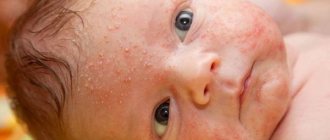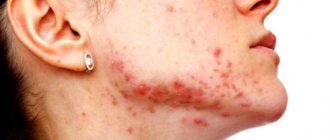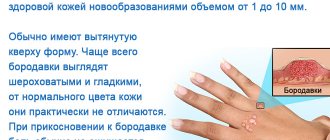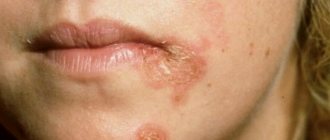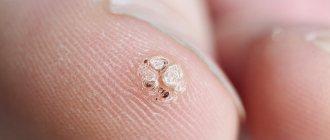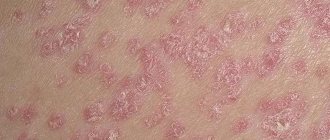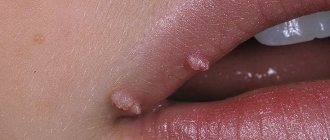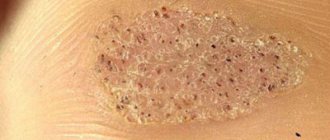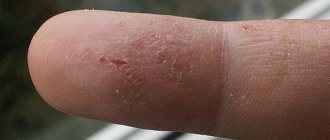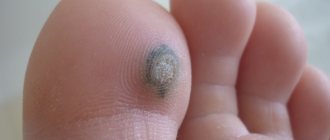Papillomas can appear on any part of the body; their origin is associated with a virus that enters wounds and begins to actively multiply in the epidermis layer. Benign neoplasms are not dangerous to humans as long as their appearance does not change and they do not begin to rapidly increase in size. Doctors recommend starting to worry when the wart becomes inflamed. This process leads to structural changes, which often become the causes of malignancy.
Types of warts
There are more than thirty types of papillomas, six of which are considered the most common:
- Vulgar (ordinary) papillomas rise above the skin, they have a round shape and clear boundaries. Most often such growths appear on the arm, less often on other parts of the body.
- Plantar warts are flat plaques, yellow or gray in color. They have a dense structure, form exclusively on the feet, and their growth is accompanied by severe pain.
- Flat juvenile papillomas occur only in adolescents. Outwardly, they look like plaques of different sizes, which slightly rise above the epidermis. Most often they appear at the site of skin injury, on the outside of the hand.
- Acrochords are growths that look like cones. Over time, they stretch out, taking the form of threads. Soft to the touch, elastic, yellowish in color. They appear in older people on the face, neck, and eyelids.
- Condylomas are genital warts, pink growths that grow on the mucous membranes of the genital organs and can also appear in the oral cavity. First, one element is formed, then a whole colony grows around it, similar in appearance to cauliflower inflorescences.
- Seborrheic keratosis (age warts). This is the only type of papillomas that is not associated with viral infection. They are formed due to the proliferation of the stratum corneum of the skin. First, a yellow-brown spot appears at the site of the future wart. It does not protrude above the skin. Then a nodule forms in its center, which gradually turns into a hard bubble with jagged edges. Over time, the papilloma darkens and becomes covered with scales. The structure becomes dense.
With good immunity, any types of papillomas disappear on their own after a few months.
How to stop bleeding
A wart is a part of the skin connected to the circulatory and nervous system. It contains a large number of capillaries. At the slightest cut, the growth bleeds and hurts. Because of this, there is a possibility of infection in the wound.
To stop bleeding, you need to do the following:
- Find a piece of clean gauze and press it tightly to the cut site;
- You need to hold the tissue until the bleeding completely stops. Sometimes it takes five to ten minutes;
- After this, the wound is treated with antiseptic agents. Hydrogen peroxide and potassium permanganate solution are suitable. The liquid is used to wipe the cut area and surrounding tissues;
- Then remove excess antibacterial composition with a piece of gauze and wrap the wound with a bandage.
Important!
Pain when palpating a growth is not always a sign of damage. Often this is a natural phenomenon caused by the peculiarity of its structure and does not indicate inflammation.
A day later, a crust appears on the growth after the cut; you cannot tear it off. This will lead to suppuration and provoke the growth of atypical cells.
Causes of inflammation
A wart can become inflamed for various reasons. Most often this occurs due to injury to the growth or in the presence of long-term adverse effects. Here are the main provoking factors:
- constant friction of the tumor against linen and clothing,
- constant pressure on the growth (wearing tight shoes),
- damage to the integrity of the papilloma during shaving, hair removal, combing,
- exposure to household chemicals.
In rare cases, the inflammatory process inside papillomas begins after a nervous shock, exposure to a series of severe stresses, or taking hormonal drugs.
For what reasons can formations on the limbs hurt?
Most often, lesions on epithelial tissue occur in these areas (as well as in the armpits), which is very uncomfortable. You can easily hit them while moving, even if completely by accident. This leads to the formation of injuries and the appearance of many problems - and it will be more difficult to remove the wart, because the “body” has been removed, and the root remains inside the epidermis (with rare exceptions, when it is still quite young).
Due to the occurrence of injuries, the growths become inflamed - this process is accompanied by quite severe pain.
Very often, the appearance of warts on the hands and fingers is due to the fact that a person works with chemically hazardous, toxic substances, or has contact with an already infected person.
Don't be surprised if you don't notice the injury right away. The growth itself, without treatment, practically cannot fall off (especially if its base remains and is even clearly visible). It is not necessary to completely rip it off; it is enough to cause a minor injury - the body will begin to hurt very much.
Manifestation of inflammation
It is not difficult to understand that the papilloma is inflamed. The skin around it turns red and swells, the wart itself changes color, it turns black, along with this a burning sensation and pain appears. Over time, such phenomena are accompanied by itching and an unpleasant odor. It forms after the appearance of pus, which comes out when you press on the painful area. Damage to the integrity of the upper cover of the growth can cause bleeding.
Inflammation of papilloma can be accompanied by symptoms of general malaise: deterioration of health, the appearance of weakness in the body, a slight increase in temperature.
This is scary?
The cause of warts in humans is the human papillomavirus. The pathogen insidiously penetrates damaged skin and settles in its upper layers, causing them to grow quickly. Moreover, after infection, months may pass before a more or less noticeable growth appears.
Warts are different: regular, flat, filiform, plantar, periungual. A separate type is genital warts, which are found on the genitals.
The disease is contagious. You can “pick up” a wart by touching another person or transfer it from yourself from one part of the body to another. The pathogen can spread through towels, socks and other objects. However, not all people who come into contact with the papilloma virus develop the disease. Wet and damaged skin is most vulnerable.
Complications of inflammation
The inflammatory process leads to disruption of the integrity of the neoplasm. Any crack, even a small one, becomes an open gate for bacteria to enter. As a result, pathogenic microorganisms penetrate into the wounds, provoking the development of a purulent process. If the plantar wart is damaged, there is a risk of a fungal infection.
An inflamed wart can transform into a purulent ulcer, which, if left untreated, will certainly grow and invade the adjacent part of the healthy epidermis.
Pain after wart removal
A wart that appears on the body does not look aesthetically pleasing, but in most cases does not cause much trouble. Sometimes there are too many of these tumors, they increase in size, become inflamed and begin to hurt. These symptoms indicate that there are quite serious health problems. Often such phenomena indicate the presence of cancer.
Important! If warts appear on the skin, you should immediately consult a doctor. Warts have a tendency to degenerate cells and cause skin cancer. A particularly alarming symptom is an inflamed, overgrown neoplasm!
How to protect a wart
If the papilloma is slightly damaged and there is no bleeding or pain, you must try to eliminate the cause of the inflammation (change underwear, shoes, remove household chemicals for a while). If there is no improvement after a few days, you need to go to the doctor.
If an inflammatory process is detected, you should not try to treat the wart yourself: cauterize the growths, remove them. The only thing that can be done is to treat the inflamed area with an antiseptic and cover it with a band-aid. After this, you should drop everything and make an appointment with a dermatologist.
There are two ways to solve the problem:
- treatment of an inflamed wart with local anti-inflammatory drugs,
- removal of growth.
It happens that the papilloma, having turned black, can fall off on its own. But it's not worth the risk. Sometimes, the described processes accompany the degeneration of a benign tumor into a malignant one. And this is a very dangerous phenomenon.
To prevent worst-case scenarios, it is important to seek prompt medical attention and undergo diagnostic testing. To exclude the onset of malignancy, you need to undergo dermatoscopy, do a biopsy of the damaged area, and take a blood test for PCR (this will identify the strain of the virus). Only after receiving all the results will the doctor be able to choose a treatment method.
Practice shows that removing an inflamed wart is the best solution. There are several radical methods. These are laser coagulation, electric cauterization, cryodestruction. The choice of removal option depends on many factors: location, area and depth of existing damage.
After removing the wart, the area where the inflamed growth was must be treated daily with hydrocortisone ointment. It is important to try to prevent sun rays from entering the wound; you cannot peel off the crust yourself; natural skin healing processes are formed under it. Their violation leads to the formation of scars.
To reduce the activity of the virus, the patient may be prescribed antiviral drugs and immunomodulators after removal of the papilloma.
If the inflamed wart falls off on its own, the wound should be treated with hydrogen peroxide, then covered with a plaster or bandage. It is important to save the fallen part and give it to the doctor for histology.
Step-by-step instructions on how to stop bleeding when a wart is damaged
As the wart grows, vessels form inside it that provide nutrition to the papilloma cells. The most vessels are found in growths located on the neck, in the groin area, and in the folds between the fingers. Bleeding can only occur if the integrity of the surface is severely damaged, since the vessels are protected on top by a thick layer of keratinized skin. If it does start, you must act immediately:
- The wart is first treated with any antiseptic.
- Take a cotton swab or gauze pad in your hands.
- They press firmly against the bleeding area.
When the bleeding stops, the wart can be treated with peroxide. If the growth hurts a lot, you need to take a painkiller and go to the doctor.
What to do if the formation on your hands hurts a lot
You can avoid all the troubles and inflammation if you immediately treat the wound with utmost care. To prevent the consequences, you need to take a few simple steps. If a wart becomes inflamed, what should you do:
- Treat the damaged area - you can use hydrogen peroxide for this.
- Carefully cover this area with a bandage and gauze.
- Be sure to see a doctor soon.
Do not try to carry out independent treatment or simply remove the formation with a thread, as this is fraught with dire consequences. If you go to a dermatologist right away, you will save yourself a lot of problems.
Is it worth removing a wart that hurts and hurts?
A wart on the back, arm or leg can be easily damaged or torn off without noticing it.
Trauma can become an impetus for the development of fleeting melanoma, sarcoma, and lead to early death.
Removing a tumor, which is often damaged, is located in a traumatic location, is the best prevention of its degeneration into a malignant tumor. Traditional surgical excision of the affected tissue remains a reliable method of prevention. The disadvantage of the operation is its pain and the scar that remains at the site of removal. With the development of medical technologies, low-traumatic methods for removing skin growths have appeared. Help to cope with the problem:
- laser,
- electro- and radiocoagulation,
- a liquid nitrogen.
The methods exclude relapse of the disease. The procedure must be carried out in a specialized medical institution, on certified equipment, by trained personnel or an appropriately qualified doctor (surgeon - dermatologist, surgeon - oncologist). Removed warts must be subjected to histological examination. In consultation with the doctor, it is permissible to use pharmaceutical preparations or traditional medicine (celandine juice, raw potatoes, garlic) to remove and relieve pain.
Possible consequences
A wart cannot become inflamed on its own, but only as a result of infection or injury caused by mechanical force. In these cases, in addition to pain, the following consequences arise:
- Itching, burning, redness and inflammation of the tissues in close proximity to the wart.
- If a wart is injured, swelling may appear, often leading to an increase in the size of the growth.
- During the inflammatory process, the wart may begin to fester. Pus appears when pressure is applied to the formation. At the same time, the patient’s body temperature may rise, and the wart begins to hurt very much.
- In some cases, the growth may change its structure and transform from benign to malignant.
Based on all of the above, it follows that papillomas should be gotten rid of immediately when they are detected, this is the only way to prevent all the unpleasant and dangerous consequences that may arise.
